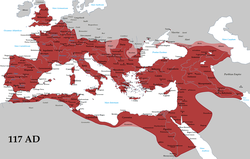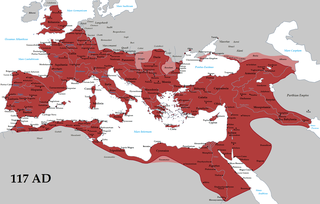Usuario:Amitie 10g/Taller/Pruebas/Pruebas de Módulo:Ficha de localidad/Imperio romano
- Actual
| Imperio romano Imperium Rōmānum | ||||||||||||||||||||||||||||||||||
|---|---|---|---|---|---|---|---|---|---|---|---|---|---|---|---|---|---|---|---|---|---|---|---|---|---|---|---|---|---|---|---|---|---|---|
| Imperio | ||||||||||||||||||||||||||||||||||
| 27 a. C.-476/1453 | ||||||||||||||||||||||||||||||||||
| ||||||||||||||||||||||||||||||||||
|
Lema: SPQR (en latín: «El Senado y el Pueblo Romano») [1] | ||||||||||||||||||||||||||||||||||
 El Imperio romano en el año 117, cuando alcanzó su máxima extensión, bajo el gobierno de Trajano. | ||||||||||||||||||||||||||||||||||
 Bajo Imperio romano en el año 394. | ||||||||||||||||||||||||||||||||||
| Capital |
Roma (27 a. C.-286) Milán (286-402) Rávena (402-476) Nicomedia (286-330) Constantinopla (330-1204, 1261-1453)[n. 1] | |||||||||||||||||||||||||||||||||
| Entidad | Imperio | |||||||||||||||||||||||||||||||||
| Idioma oficial | Latín, griego | |||||||||||||||||||||||||||||||||
| • Otros idiomas | Véase Lenguas del Imperio romano | |||||||||||||||||||||||||||||||||
| Superficie hist. | ||||||||||||||||||||||||||||||||||
| • 27 a. C.[1] | 2 750 000 km² | |||||||||||||||||||||||||||||||||
| • 117[1][3] | 5 000 000 km² | |||||||||||||||||||||||||||||||||
| • 395[1] | 4 400 000 km² | |||||||||||||||||||||||||||||||||
| Población hist. | ||||||||||||||||||||||||||||||||||
| • 14 [n. 2] est. | 56 800 000 hab. | |||||||||||||||||||||||||||||||||
| • 117[1][3] est. | 88 000 000 hab. | |||||||||||||||||||||||||||||||||
| Religión |
Politeísmo romano (27 a. C.-270 d. C.) Monismo solar (270-380) Cristianismo (380-1453) | |||||||||||||||||||||||||||||||||
| Moneda | Denario, sestercio, sólido bizantino | |||||||||||||||||||||||||||||||||
| Período histórico | Edad Antigua y Media | |||||||||||||||||||||||||||||||||
| • 16 de enero de 27 a. C. | El Senado proclama a Octavio como Augusto | |||||||||||||||||||||||||||||||||
| • 1 de abril de 286 | Primera división del Imperio | |||||||||||||||||||||||||||||||||
| • 17 de enero de 395 | División final entre Occidente y Oriente | |||||||||||||||||||||||||||||||||
| • 4 de septiembre de 476 | Caída de Occidente | |||||||||||||||||||||||||||||||||
| • 29 de mayo de 1453 | Caída de Oriente | |||||||||||||||||||||||||||||||||
| Forma de gobierno | Autocracia | |||||||||||||||||||||||||||||||||
| Emperador[n. 3] • 27 a. C.-14 d. C. • 1449-1453 |
Augusto Constantino XI | |||||||||||||||||||||||||||||||||
| Cónsul[n. 4] • 27 a. C. • 886 d. C. |
Augusto, Agripa León VI el Sabio | |||||||||||||||||||||||||||||||||
| Legislatura |
Senado romano Senado bizantino | |||||||||||||||||||||||||||||||||
| ||||||||||||||||||||||||||||||||||
- Propuesta
| Imperio romano Imperium Rōmānum | |||||
|---|---|---|---|---|---|
| Imperio | |||||
| 27 a. C.-476/1453 | |||||
| |||||
|
Lema: SPQR (en latín: «El Senado y el Pueblo Romano») [1] | |||||
 El Imperio romano en el año 117, cuando alcanzó su máxima extensión, bajo el gobierno de Trajano. | |||||
 Bajo Imperio romano en el año 394. | |||||
| Forma de gobierno | Autocracia | ||||
| Órgano legislativo | Senado del Imperio Romano | ||||
| Religión |
Politeísmo romano (27 a. C.-270 d. C.) Monismo solar (270-380) Cristianismo (380-1453) | ||||
| Moneda | Denario, sestercio, sólido bizantino | ||||
| |||||
- Propuesta (sin datos locales)
| Imperio romano Imperium Romanum (latín) Βασιλεία τῶν Ῥωμαίων (griego antiguo) | |||||
|---|---|---|---|---|---|
| estado desaparecido | |||||
 | |||||
| Forma de gobierno | monarquía absoluta | ||||
| Órgano legislativo | Senado del Imperio Romano | ||||
| Religión | religión de la Antigua Roma e Iglesia estatal del Imperio romano | ||||
| Moneda | sestercio, denario, moneda en la Antigua Roma, áureo y as | ||||
| |||||
Error en la cita: Existen etiquetas <ref> para un grupo llamado «n.», pero no se encontró la etiqueta <references group="n."/> correspondiente.
- ↑ a b c d e f Taagepera, Rein (1979). «Size and Duration of Empires: Growth–Decline Curves, 600 BC to 600 AD». Social Science History (en inglés) (3.ª/4.ª edición) 3: 115–138 [125]. JSTOR 1170959. doi:10.2307/1170959.
- ↑ Durand, John D. (1974). «Historical Estimates of World Population: An Evaluation». PSC Analytical and Technical Reports Series (Universidad de Pensilvania) 10: 27-31. doi:10.2307/1971891.
- ↑ a b Turchin, Peter; Adams, Jonathan M.; Hall, Thomas D (2006). "East-West Orientation of Historical Empires" (PDF). Journal of World-Systems Research. 12 (2): 125. ISSN 1076-156X
- ↑ Canning, Joseph (1996). «Ideas of an Empire». A History of Medieval Political Thought, 300-1450. Psychology Press. pp. 67-70. ISBN 9780415013505.
- ↑ Gregorovius, Ferdinand (1894). George Bell, ed. History of the City of Rome in the Middle Ages, Vol. 1 (en inglés). Universidad de California. pp. 335-336.
- ↑ Riedel, Meredith L. D. (2018). Leo VI and the Transformation of Byzantine Christian Identity. Cambridge University Press. p. 100. ISBN 9781107053076.
- ↑ Durand, John D. (1974). «Historical Estimates of World Population: An Evaluation». PSC Analytical and Technical Reports Series (Universidad de Pensilvania) 10: 27-31. doi:10.2307/1971891.
- ↑ Canning, Joseph (1996). «Ideas of an Empire». A History of Medieval Political Thought, 300-1450. Psychology Press. pp. 67-70. ISBN 9780415013505.
- ↑ Gregorovius, Ferdinand (1894). George Bell, ed. History of the City of Rome in the Middle Ages, Vol. 1 (en inglés). Universidad de California. pp. 335-336.
- ↑ Riedel, Meredith L. D. (2018). Leo VI and the Transformation of Byzantine Christian Identity. Cambridge University Press. p. 100. ISBN 9781107053076.


